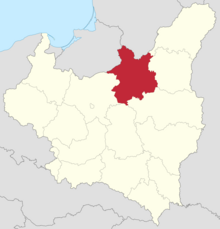|
Białystok Voivodeship (1919–1939)
Białystok Voivodeship (Polish: Województwo białostockie) was an administrative unit of interwar Poland (1918–1939). The province's capital and its biggest city was Białystok with a population of over 91,000 people. Following the Nazi German and the Soviet invasion of Poland, the Voivodeship was occupied by both invading armies and divided according to Nazi-Soviet boundary treaty. Area and locationIn interwar Poland (1918–1939), Bialystok Voivodeship was located in the country's mid-northern part. It bordered Germany (East Prussia) to the north-west, Lithuania to the north-east, Wilno Voivodeship and Nowogródek Voivodeship to the east, Polesie Voivodeship and Lublin Voivodeship to the south and Warsaw Voivodeship to the west. Its area was 26 036 km2. The landscape was flat, with the mighty Bialowieza Forest located right in the middle. PopulationInhabited mostly by Poles (in 1931 they made up 66.9% of the population), it also had significant Belarusian (16.3%) and Jewish (12.1%) minorities. Interestingly, in 1931, 2.8% claimed Russian as their native tongue. The population, according to the 1931 Polish census was 1 643 844. According to Polish data from April 1939, the population of Białystok voivodship was divided as follows: 71,1% Poles, 13,5% Belarusians, 11,9% Jews, 2,2% Russians, 0,9% Lithuanians, 0,5% Germans.[1] HistoryOn February 4, 1921 the voivodeship was expanded by three more counties: Grodno, Wołkowysk and Białowieża. From 10 July 1930 to the end of February 1934, Marian Zyndram-Kościałkowski was the Voivode of Białystok. During this time, he streamlined administration, increased supervision of officials, and prioritised the development of sewers and streets in Bialystok. He also founded the Regional Committee for Unemployment, as well as had their share in the creation of the Agricultural Chamber of Białystok and ensuring the participation of entrepreneurs in the second Bialystok Fair Vilnius. He was also one of the founders of Jagiellonia Białystok Sports Club (of which he was honorary president of the club).[2] In November 1930, Marian Zyndram-Kościałkowski once again became a member of parliament (he was 17th on the list of the Nonpartisan Bloc for Cooperation with the Government (BBWR).[3] In 1932, Zyndram-Kościałkowski remained at the disposal of the head of the department and the Ministry of Defense Corps. Administrative divisions
 Cities and towns The Voivodeship consisted of thirteen counties (powiaty): According to the 1931 census, the most significant cities were:
Railroads and industryIn the interwar period, Białystok Voivodeship was part of the so-called "Poland B". This meant that it was underdeveloped, with 23.1% of the population being illiterate. Railroad networks were scarce (total length 1 377 km., density – 4.2 per 100 km2), and forested areas covered 24.4% of Voivodeship's area. The city of Białystok (whose population reached 107 000 in 1939), was the Voivodeship's lone industrial centre. Agriculture was at a low level. Voivodes
1931 censusThe results of the 1931 census (questions about mother tongue and about religion) are presented in the table below: Counties with Orthodox/Greek Catholic plurality are highlighted with yellow.
See also
Notes
References
|
||||||||||||||||||||||||||||||||||||||||||||||||||||||||||||||||||||||||||||||||||||||||||||||||||||||||||||||||||||||||||||||||||||||||||||||||||||||||||||||||||||||||||||||||||||||||||||||||||||||||||||||||||||||||||||||||||||||||||||||||||||||||



